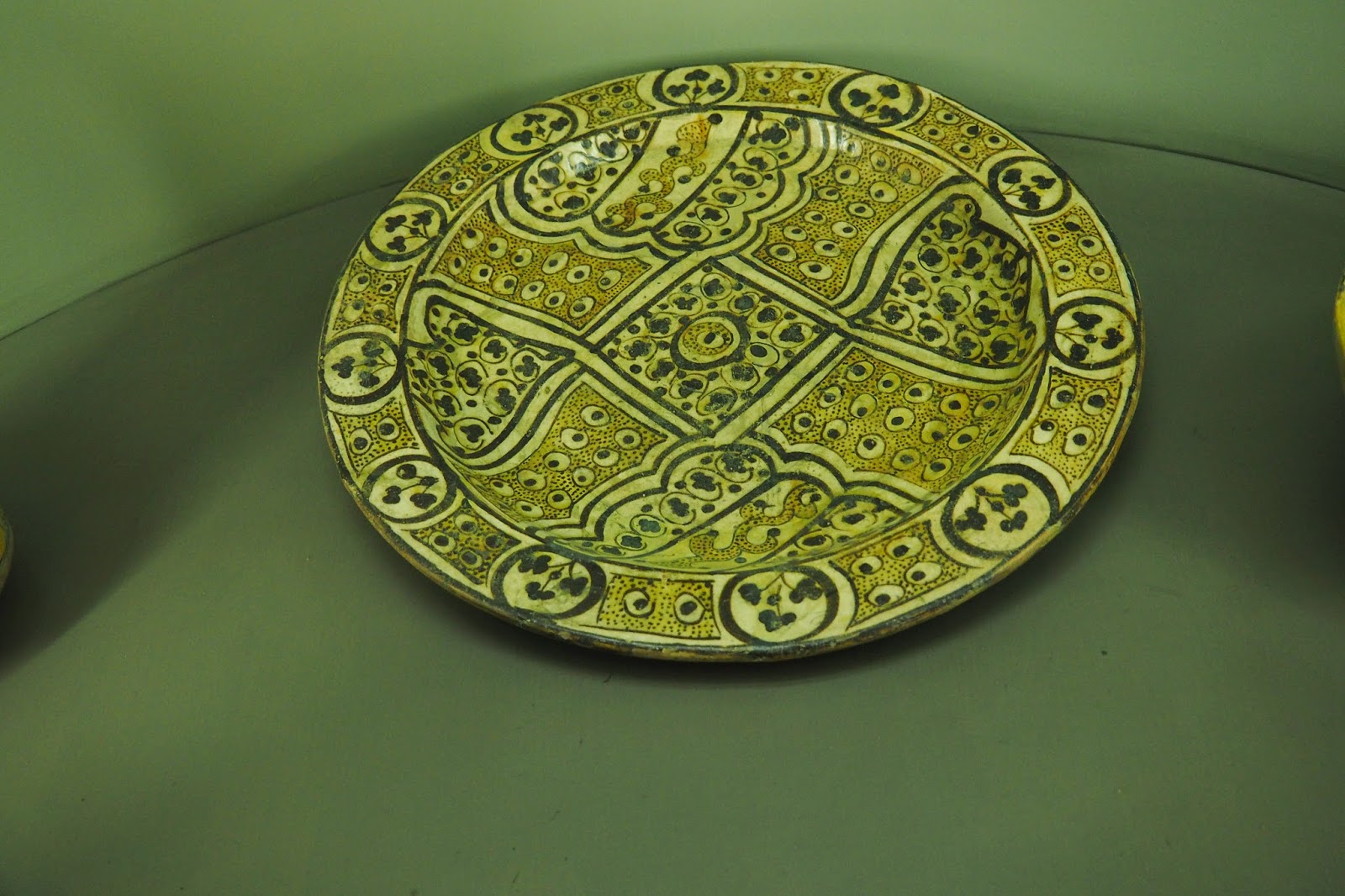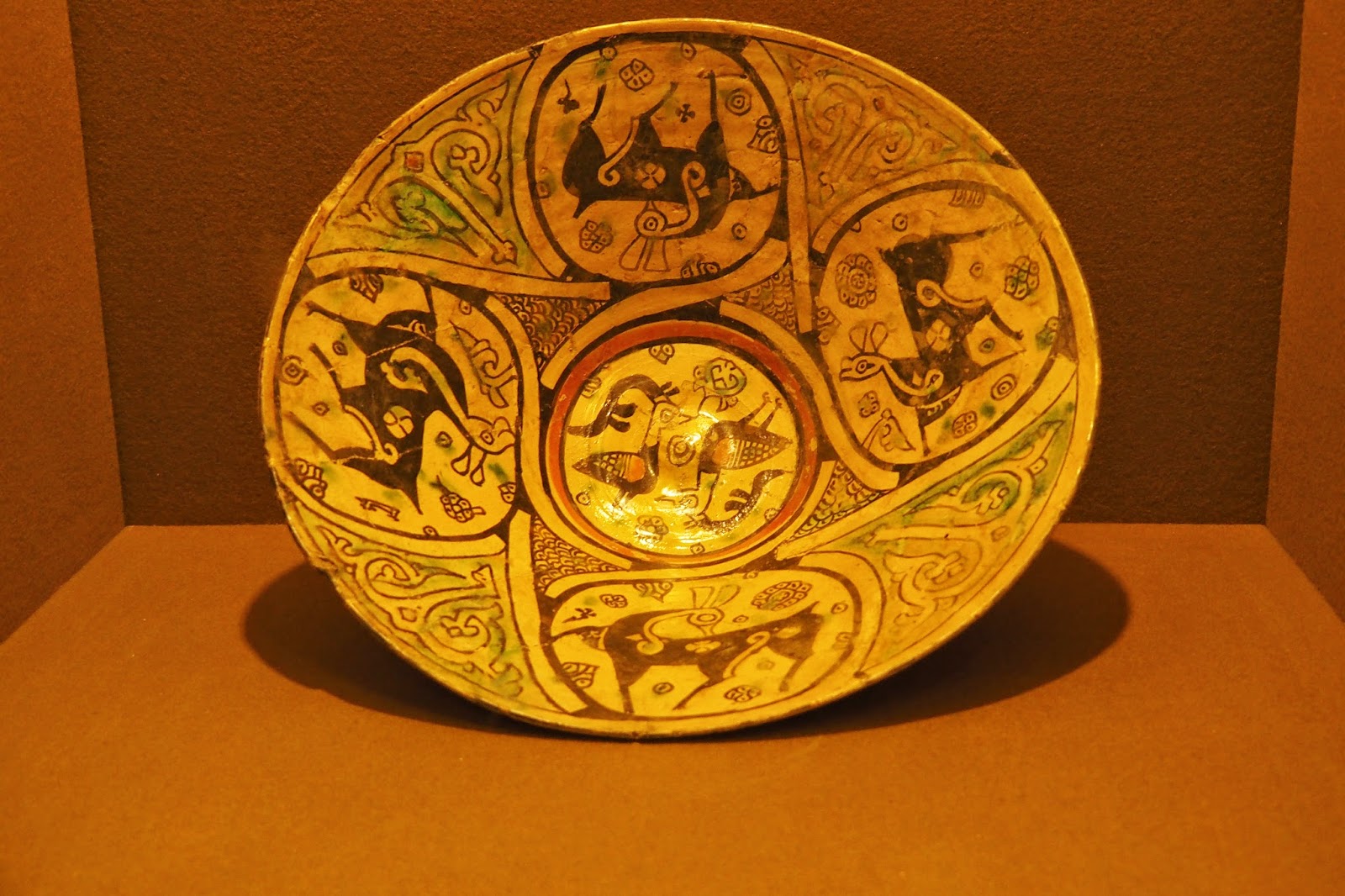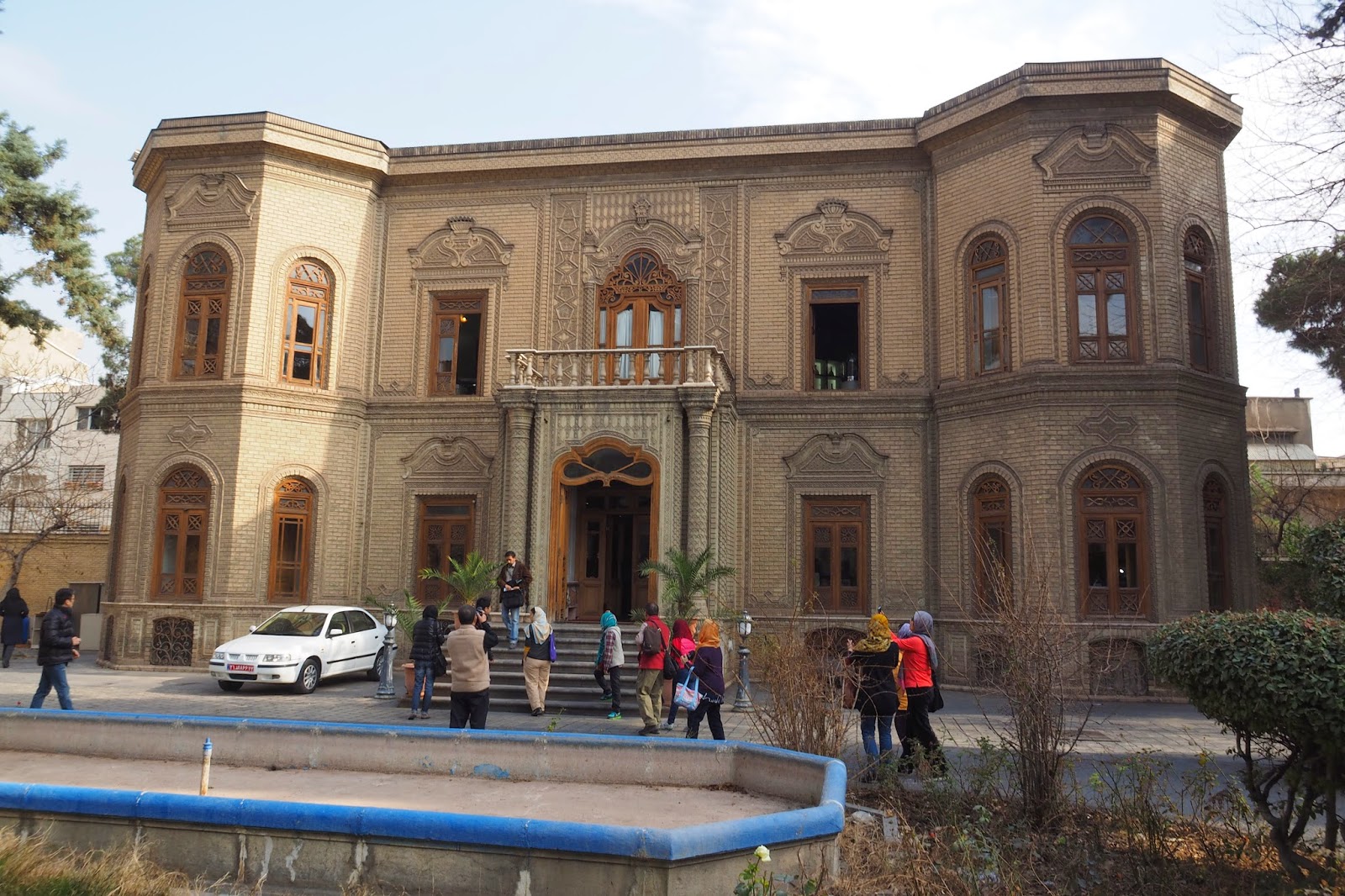Originally built some 90 years ago by Ahmad Qavam ol-Saltaneh as his residence and office on a 7,000-CM2 garden and used by him till 1953 when this 2-storey octagonal building in mixed Iranian and 19th century European style was sold to the Egyptians as their embassy and remained such for 7 years until it was closed when Iranian-Egyptian relation turned sour during the presidency of Abdul Nasser in Egypt, when it was sold first to the Commercial Bank and later to Farah Pahlavi in 1976 when she got some Iranian, Austrian and French architects to turn it into a museum. The building has some suspended pillars and a basement with the first floor connected to the second through wooden Russian-style steps with double windows instead of terrace and wooden doors behind the windowpanes to regulate the light and temperature and houses rare glass and ceramics dating back from the 4th millennium B.C. up to the contemporary era and especially 18th and 19th century European glass works in six halls and two entrance halls in separate sections depicting different historical eras and subjects.
Probably the contents of this glass covered trough at the entrance hall is intended as a foretaste of what we may expect from this museum in matters related to history of pottery in the desert strewn country of Iran.
A handwritten classification of Iranian cultures and dynasties: almost like the kind of work produced by a high school kid for a class project on culture. Perhaps awaiting the budget for a more professional presentation?

A comparative chronological chart of different European, West Asian, Indian, Chinese and Iranian dynastic periods
Pottery making in the Iranian Plateau dates back to the Early Neolithic Age (7th millennium BCE) with the production of coarse, unglazed wares and a little later ceramics were made from earthenware clays with a layer of white slip (engobe), covered by transparent lead glazes. Colors were added with oxides. With time, Persian ceramics matured into more elaborate styles and techniques. When the Arabs conquered Persia, Syria, Palestine and Mesopotamia in the 7th century, and in the 8th, a large part of North Africa including Egypt and then the Iberian Peninsula took place, the Arab empire set the stage for the development of the eclectic Persian art forms based on Roman, Greek, Egyptian, and Central Asiatic ideas so that such new forms and styles of Persian glass making became exportable items. Such styles and techniques were were refined under the 9th century Abbasids: the use of cobalt blue dates to this period, as does the use of other metallic oxides, such as copper, to produce blues and greens. At more ore less the same period, potters experimented with slip decorations, and were able to control the liquid slip to create more elaborate and intricate decorations. Such colors as manganese purple, tomato red, olive green, yellow and brown were first painted on the surface and then covered over with a transparent glaze, creating a glossy and smooth finish. With the import of Chinese porcelain, Persian potters made serious efforts to emulate the Chinese potter's porcelain ware but failed because they lacked kaolin, a fine clay used for the production of Chinese porcelain. With the introduction of the fritware or faience (an Islamic stone paste which helps to lower the firing temperature for the production of ceramics first invented in the late 1st millenium ),however, Persian potters were able to produce the smooth surface they sought. This new clay body was composed of white clay, powdered glass and quartz. Its soft consistency facilitated the use of new techniques such as engraving, piercing and molding.
A replica of a 12th century mini ceramic bowl found in Eastern Iran at the entrance hall
The famed double window and door on the staircase landing leading to the first floor
From left to right: two mid-2nd millenium BCE female figurines from southwest Iran and a 6th millenium BCE female figurine from an unknown place in Iran
An interestingly shaped 8th century BCE compound vessel found in Azarbaijan
An interestingly shaped 8th century BCE compound vessel found in Azarbaijan
a 1st millenium BCE ceramic ewer (jug) found in NW Persia
A beautiful1st millenium BCE rhyton with graceful lines found at Marik Province
A beautiful1st millenium BCE rhyton with graceful lines found at Marik Province
Various 2nd century glass amphoras for perfume from Eastern Mediterranean: the second on the left on the 2nd row displays the kind of "face" found in some bronze and jadework from the Western part of ancient China
a 3rd century glass vessel from Syria (?)
A 3rd-4th century free blown engraved and glazed glass flask from East Iran
Tiny 4th-6th century BCE toy heads from Black Sea civilizations

A glazed Islamic bowl from Saveh

9th to 10th century glazed wheel-made bowl origin untraceable

a 9th-10th century plate painted with bird and human figure from an untraceable location in Persia

A 10th century bowl wheel made and slip painted dish origin untraceable

A 10th century lustre painted bowl from Rey with leaf and/or bird like and human face motifs against some matted background



A 10th century dish from Nishapur divided into 4 main sections each with a mixed bird-animal design

Another 10th century bowl from Nishapur with a human figure in the centre being offered some leaves

A 10th century pot from Nishapur with two birds
A 10th century bowl lustre painted from Nishapur with stylized plant design
Two 12th- 13th century lustre painted ceramic pitchers from Rey with slightly differently colored human figures
another lustre painted ceramic plate from the same regions in the same period with women on the circumference and fishes in the middle: mermaids?
A similar type of plate in the same period from Kashan with women and man above and abstract patterns below
another similar large plate of women from the same period from Gorgan

Another similar plate but separated by windmill like leaves partly covering the women
A lustre painted ceramic ewer in the period from Kashan again with women both at the top of the neck and on the body of the pot
A more elaborate lustre painted ewer in the same period with flower motifs and plant from the same place but different in that it is also moulded
Another one from the same period and the same place but this one has stupid looking cock at the top
A most elaborately designed 12th-13th century ceramic vessel from Gorgan with 5 handles with what appears to be words and what looks like a man in one of the sections at the bulb close to the mouth of the neck.
A lustre painted pitcher with a two barrels one with asterisks and the other with some human and bird figures below from 13th century Gorgan
Dishes from the 10th to 12th centuries with painted underglaze from Gorgan

Various 10th-11th century dishes from Nishapur with abstract floral and animal motifs

10th-11th century dish from Nishapur with floral designs

11th century underglazed ceramic bowl with human relief from Nishapur


A 12th century perforated bowl from Nishapur

A 12th century underglazed jug from Gorgan


13th century lustre painted plate from Kashan with two women at the centre and abstract patterns on the periphery

Another two women in the middle with a different design
Another 13th century plate with women probably from Gorgan
A contemporary ceramic hubble-bub from Calpurgan
A contemporary multi-color wheel made vessel

Various 10th-11th century dishes from Nishapur with abstract floral and animal motifs

10th-11th century dish from Nishapur with floral designs

11th century underglazed ceramic bowl with human relief from Nishapur

Two 12th century monochrome vases from Gorgan the one on the right with carved designs

12th century glazed ceramic ewer with handle from Gorgan
12th-13th century blue pot from Kashan

12th century glazed ceramic ewer with handle from Gorgan
12th-13th century blue pot from Kashan

A 12th century perforated bowl from Nishapur

A 12th century underglazed jug from Gorgan


13th century lustre painted plate from Kashan with two women at the centre and abstract patterns on the periphery

Another two women in the middle with a different design

Another 13th century plate with women probably from Gorgan
A contemporary ceramic hubble-bub from Calpurgan
A contemporary multi-color wheel made vessel
A cut glass fruit bowl adorns the entrance hall on the 1st floor.

A 9th century glass beaker from Minai

A 9th century glass beaker from Nishapur

A 9th century perfume bottle from Gorgon

It was between the 5th and 4th centuries BCE that a new technology for moulding and pressing glass was discovered as well as the art of making clear glass and later colorless glass. There is archaelogical evidence that glass making began in Mesopotami around 3500 BCE and that the first true glass was made in coastal northern Syria, Mesopotamia or Ancient Egypt. The earliest known glass objects, of the mid-3rd millennium BCE, were beads, perhaps initially created as accidental by-products of metal-working (slags) or during the production of faience, a pre-glass vitreous material made by a process similar to glazing . Between the 6th-4th centuries BCE, the Achaemenian court began to go into colorless glass in a big way and the Athenian ambassador to the court of Persia talked of Persians drinking their wine from glass cups, something also referred to by Aristophanes (448-385 BCE) Some such glasses have been discovered in Anatolia on the Black Sea. For the most part, they are transparent, untinted and mould-blown with some wheel-cut rosette decoration. Glass objects became a flourishing trade between cities of the the Mediterranean and Middle East cities. Syrian glass items made for the Parthian Empire (240 BCE-224 CE) are still being discovered from Azarbaijan, Gilan and western Iran. Wheel cutting, facet cutting during the Sassanian dynasty(240-620 CE) but the period also produced some linear cut e.g. hemispherical bowl with concave cut facets were exported to both the West and the East as far as Japan.
The Russian staircase leading up to the first floor from the entrance hall
A 19th century blown and painted French crystalline vessel at the centre of the entrance hall
4 oil painted glass vessel from 19th century Tehran

A 9th century glass beaker from Minai

A 9th century glass beaker from Nishapur

A 9th century perfume bottle from Gorgon

A glass jug from 10th to 11th century origin untraceable
a 10th to 11th century mosque lamp from Gorgan

a 12th century free blown glass bottle from Gorgan

13th century molded glass bottle from Gorgan
20th century painted glass rose water sprinkler from Shiraz
20th century painted glass rose water sprinkler from Shiraz
Various glass vase, cups, boxes, bottles, candle stands etc in a glass encasement
A close up of one of the bottles with the most elaborate gilded floral design
a beautiful blue casket with a bird and floral design
a gilded orange colored chalice
Some naturally occurring glass and materials used for the production or coloring of glass
There were of course many many more exhibits at the museum but time is a real constraint.
(To be cont'd)




















































沒有留言:
張貼留言